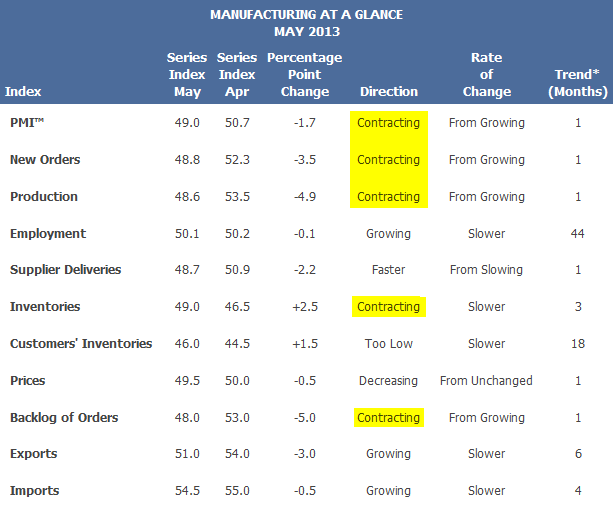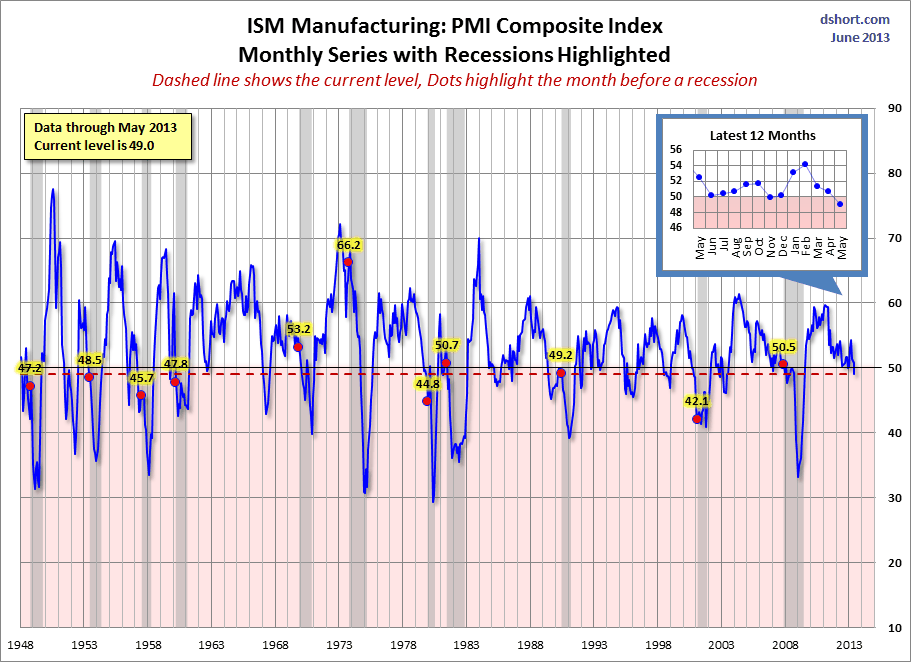Yesterday, the Institute for Supply Management published its May Manufacturing Report. The latest headline PMI at 49.0 percent is the first month of contraction following five months of modest expansion and only the fourth month of contraction since the end of the Great Recession. In fact that one month of contraction last November at 49.9 was the direct result of Superstorm Sandy. Today's number is the lowest since June 2009. The Briefing.com consensus was for 50.7 percent.
Here is the key analysis from the report:
Manufacturing contracted in May as the PMI™ registered 49 percent, a decrease of 1.7 percentage points when compared to April's reading of 50.7 percent. This month's reading reflects the second month of contraction in the manufacturing sector since July 2009, when the index registered 49.9 percent. It is also the lowest reading for the PMI™ since June 2009, when the index registered 45.8 percent. A reading above 50 percent indicates that the manufacturing economy is generally expanding; below 50 percent indicates that it is generally contracting.
A PMI™ in excess of 42.2 percent, over a period of time, generally indicates an expansion of the overall economy. Therefore, the May PMI™ indicates growth for the 48th consecutive month in the overall economy, and indicates contraction in the manufacturing sector for the first time since November 2012. Holcomb stated, "The past relationship between the PMI™ and the overall economy indicates that the average PMI™ for January through May (51.7 percent) corresponds to a 3 percent increase in real gross domestic product (GDP) on an annualized basis. In addition, if the PMI™ for May (49 percent) is annualized, it corresponds to a 2.1 percent increase in real GDP annually."
Here is the table of PMI components. I've highighted the ones that are contracting. Note that employment is still above 50 for this diffusion index but was slowing in May.
I'm reluctant to put too much focus on this index for various reasons, but they are essentially captured in Briefing.com's Big Picture comment on this economic indicator.
This [the ISM Manufacturing Index] is a highly overrated index. It is merely a survey of purchasing managers. It is a diffusion index, which means that it reflects the number of people saying conditions are better compared to the number saying conditions are worse. It does not weight for size of the firm, or for the degree of better/worse. It can therefore underestimate conditions if there is a great deal of strength in a few firms. The data have thus not been either a good forecasting tool or a good read on current conditions during this business cycle. It must be recognized that the index is not hard data of any kind, but simply a survey that provides broad indications of trends.
The chart below shows the Manufacturing Composite series, which stretches back to 1948. I've highlighted the eleven recessions during this time frame and highlighted the index value the month before the recession starts. 
For a diffusion index, the latest reading of 50.7 indicates weak expansion. What sort of correlation does that have with the months before the start of recessions? Here are the eleven data points for the months before recessions arranged in numeric order with the latest data pointed inserted in the sequence (highlighted in red).
42.1, 44.8, 45.7, 47.2, 47.8, 48.5, 49.0, 49.2, 50.5, 50.7, 53.2, 66.2
Yesterday's reading is right in the middle of the pack, with six lower and five higher.
But how revealing is yesterday's 1.7 point change from last month? There are 785 monthly data points in this series. The average month-to-month point change is 2.01 points. So yesterday's headline PMI number is 15% below the mean change.
To reiterate the Briefing.com assessment: "The data have thus not been either a good forecasting tool or a good read on current conditions during this business cycle." The ISM reports nevertheless offer an interesting sidebar to the ongoing economic debate.
Note: I use the FRED USRECP series (Peak through the Period preceding the Trough) to highlight the recessions in the charts above. For example, the NBER dates the last cycle peak as December 2007, the trough as June 2009 and the duration as 18 months. The USRECP series thus flags December 2007 as the start of the recession and May 2009 as the last month of the recession, giving us the 18-month duration. The dot for the last recession in the charts above are thus for November 2007. the "Peak through the Period preceding the Trough" series is the one FRED uses in its monthly charts, as illustrated here.
- English (UK)
- English (India)
- English (Canada)
- English (Australia)
- English (South Africa)
- English (Philippines)
- English (Nigeria)
- Deutsch
- Español (España)
- Español (México)
- Français
- Italiano
- Nederlands
- Português (Portugal)
- Polski
- Português (Brasil)
- Русский
- Türkçe
- العربية
- Ελληνικά
- Svenska
- Suomi
- עברית
- 日本語
- 한국어
- 简体中文
- 繁體中文
- Bahasa Indonesia
- Bahasa Melayu
- ไทย
- Tiếng Việt
- हिंदी
ISM Manufacturing Index Contracts, Worst Level Since June 2009
Published 06/04/2013, 01:59 AM
Updated 07/09/2023, 06:31 AM
ISM Manufacturing Index Contracts, Worst Level Since June 2009
Latest comments
Loading next article…
Install Our App
Risk Disclosure: Trading in financial instruments and/or cryptocurrencies involves high risks including the risk of losing some, or all, of your investment amount, and may not be suitable for all investors. Prices of cryptocurrencies are extremely volatile and may be affected by external factors such as financial, regulatory or political events. Trading on margin increases the financial risks.
Before deciding to trade in financial instrument or cryptocurrencies you should be fully informed of the risks and costs associated with trading the financial markets, carefully consider your investment objectives, level of experience, and risk appetite, and seek professional advice where needed.
Fusion Media would like to remind you that the data contained in this website is not necessarily real-time nor accurate. The data and prices on the website are not necessarily provided by any market or exchange, but may be provided by market makers, and so prices may not be accurate and may differ from the actual price at any given market, meaning prices are indicative and not appropriate for trading purposes. Fusion Media and any provider of the data contained in this website will not accept liability for any loss or damage as a result of your trading, or your reliance on the information contained within this website.
It is prohibited to use, store, reproduce, display, modify, transmit or distribute the data contained in this website without the explicit prior written permission of Fusion Media and/or the data provider. All intellectual property rights are reserved by the providers and/or the exchange providing the data contained in this website.
Fusion Media may be compensated by the advertisers that appear on the website, based on your interaction with the advertisements or advertisers.
Before deciding to trade in financial instrument or cryptocurrencies you should be fully informed of the risks and costs associated with trading the financial markets, carefully consider your investment objectives, level of experience, and risk appetite, and seek professional advice where needed.
Fusion Media would like to remind you that the data contained in this website is not necessarily real-time nor accurate. The data and prices on the website are not necessarily provided by any market or exchange, but may be provided by market makers, and so prices may not be accurate and may differ from the actual price at any given market, meaning prices are indicative and not appropriate for trading purposes. Fusion Media and any provider of the data contained in this website will not accept liability for any loss or damage as a result of your trading, or your reliance on the information contained within this website.
It is prohibited to use, store, reproduce, display, modify, transmit or distribute the data contained in this website without the explicit prior written permission of Fusion Media and/or the data provider. All intellectual property rights are reserved by the providers and/or the exchange providing the data contained in this website.
Fusion Media may be compensated by the advertisers that appear on the website, based on your interaction with the advertisements or advertisers.
© 2007-2024 - Fusion Media Limited. All Rights Reserved.
